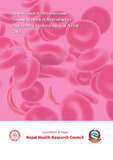Please use this identifier to cite or link to this item:
https://hdl.handle.net/20.500.14356/762| Title: | Anemia and its Determinants among Women of Reproductive Age in Mid-Western Tarai of Nepal 2015 |
| Authors: | Karki, Khem Bahadur Thapa, Pushpa Dhimal, Meghnath Bista, Bihungum Joshi, Aishana Poudyal, Anil Dhakal, Purushottam Aryal, Krishna Kumar |
| Citation: | Karki KB, Thapa P, Dhimal M, Bista B, Joshi A, Poudyal A, Dhakal P, Aryal KK. Anemia and its Determinants among Women of Reproductive Age in Mid-Western Tarai of Nepal, 2015. Kathmandu, Nepal: Nepal Health Research Council, 2016. |
| Issue Date: | 2016 |
| Publisher: | Nepal Health Research Council |
| Keywords: | Anemia Reproductive Age Mid-Western Terai |
| Abstract: | Executive Summary: Despite a number of targeted interventions, anemia still poses a huge challenge by ruling one-third Nepalese women as anemic. According to Nepal Demographic and Health Survey 2006 and 2011, Anemia prevalence among women of reproductive age group is stagnant compared to the previous survey. Evidences assembled around the world provide an insight to many important contributors to anemia. Evidence around the factors contributing to anemia is scarce. Understanding what drives anemia among this vulnerable populace would be worthwhile, with a great significance on planning and implementing sensitive and specific nutrition interventions. Therefore, this study came as an endeavor with an objective of unveiling the determinants of anemia among women of reproductive age of Mid-western Taraiof Nepal. This was a descriptive, cross-sectional study executed in Dang, Banke, and Bardiya. A total of 849 (response rate: 99.7%, computed sample 852) women of reproductive age agreed to be the part of study, who were drawn through probability proportional to size sampling. The 781research participants (response rate: 91.7%) gave written consent for extraction of blood sample, and 791research participants (response rate: 92.8%) provided stool sample. A standard semi-structured questionnaire was employed to assess sociodemographic and behavioral aspects. Laboratory tests were done for blood and stool specimens using validated tool.The study soughtan approval from the Ethical Review Board of the Nepal Health Research Council. Trained enumerators underwent a faceto-face interview, after selected samples granted a written consent. Anthropometric measurements together with blood and stool sample collection were undertaken by a group of laboratory technicians in the following day. Stool samples were analyzed in the field laboratory set up made by the research team under close supervision of senior medical lab technologists. Blood specimens were transported the same evening to Kathmandu which was then handed over to Civil Service Hospital, Kathmandu for the analysis. Data were analyzed in Statistical Package for Social Sciences software full version 20. The results of the current study are presented on the ground of univariate and bivariate analysis. |
| URI: | http://103.69.126.140:8080/handle/20.500.14356/762 |
| Appears in Collections: | NHRC Research Report |
Files in This Item:
| File | Description | Size | Format | |
|---|---|---|---|---|
| Anemia and its Determinants among Women of Reproductive Age in Mid-Western Tarai of Nepal 2015.pdf | View Full Text Report. | 1.77 MB | Adobe PDF |  View/Open |
Items in DSpace are protected by copyright, with all rights reserved, unless otherwise indicated.
